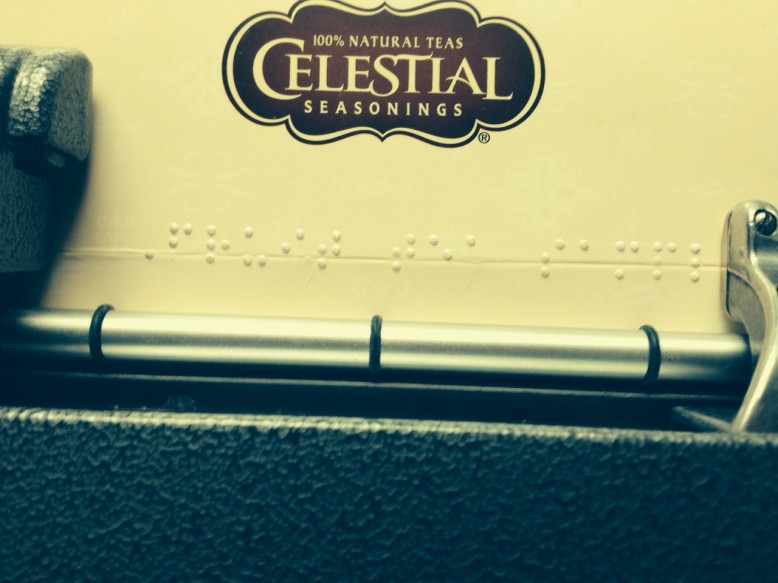
A brailler is embossing “fruit tea sampler” on the cardboard lid of a box of tea.
August has ended and the school year is beginning. What about stretching your brain by learning braille? The Hadley School offers free tuition by mail or the internet. If you have a patterning kind of brain, it’s not hard to learn Grade 1 and even Grade 2 Bbraille. It can be a thrill when you are trying to cope with vision loss to find a means of communication devoted to your new sensory setup. But learning the braille code is just the first step.
Learning to read it is a very different matter. In research into braille and the brain, Hamilton and Pascual say “Blind Braille readers must discriminate, with exquisite sensitivity and accuracy, subtle patterns of raised and depressed dots with the pads of their fingers and translate this spatial code into meaningful information. Faced with the complex cognitive demands of Braille reading, it appears that striking adaptive changes occur in the human brain.”
It is a comfort to find that you are not a doofus who can’t learn what everyone else is clearly going to master in a few lessons! Learning to read braille as an adult is frustratingly slow because new neural pathways have to be developed in your brain.
Why bother now that everything is available with text to speech or recording? Well, you do need basic information about the contents of food packages, seasonings, cleaning products etc. For this kind of brief information or label, a bump dot is not enough and a recorded label may be more than you need. Also with braille, you don’t have to locate your lighted magnifier, audio labeler, or an app on your smart device, you just use your fingers.
You can decipher the position of those tiny bumps more easily when:
you have written it yourself
the braille is embossed on plastic
the letters have spaces in between
the words are kept short or abbreviated
There are two basic ways to make a plastic braille label. You can purchase a Braille Labeler for DYMO tape (about $35), or ask your case worker at your Commission for the Blind to give you a braille writer. The brailler doesn’t have to be new. A reconditioned model will be fine and sometimes there are some in a closet at the commission. You will also need a DYMO frame to go with your brailler. Both devices take 1/2inch plastic DYMO tape with self-adhesive backing, but the brailler will do much more besides. You could begin with half a dozen favorite seasonings: CIN, GAR, BAS, etc. stuck onto the lids of the jars. This will save you a lot of unscrewing and sniffing! Always place the labels onto the llid or sprayer or top of the container. This is for 2 reasons. First the lid or top is small and easy to find and second you can often transfer the top to a new bottle, saving yourself a relabeling job.
When you have labeled some seasonings, cleaning supplies and toiletries, etc. with short, spaced names, you may find braille reading getting a bit easier and progress to putting the letters next to each other, or even using some Grade 2 contractions. There is another useful trick which Kate Crohan, a braille expert, showed me. For this you do need a brailler. You unstick the flap on top of a box of crackers, cake mix, tea, etc. and push the cardboard flap straight into the brailler. Then you emboss the name right onto the lid. You can’t reuse the label of course, but it is quick and handy.
It is a lot of effort to learn to read braille but think of how those complex cognitive demands are reducing your risk of Alzheimer’s! Gradually those subtle patterns of raised and depressed dots . . . translate this spatial code into meaningful information. Reading braille, even if it’s only for finding the cinnamon, will impress your family and make you proud of yourself!
Do you have braille labeling tips? Or want to Tell us how you learned to read braille? Please post a comment here.
This was really interesting to me. It’s a good point about keeping your brain healthy by learning new things. The link for the braille labeler took me to the article by Hamilton and Pascual, so I think that might need to be fixed.
Thank you Janice. My apologies for the error , which is now fixed.Hannah